The Battle of Jutland : May 1916
- Home
- World War I Articles
- The Battle of Jutland : May 1916
Of the countless acts of gallantry took place during the First World War, only a small proportion were recognised with the Victoria Cross. Many of those who were awarded the VC were not out of their teens, for example Thomas Ricketts of the Royal Newfoundland Regiment earned his in 1918 when aged 17.
The youngest winner of the VC in the Great War was John Travers ('Jack') Cornwell, aged 16, of the Royal Navy. Cornwell was posthumously awarded the VC for the part he played during the Battle of Jutland in May 1916.

The obverse of a 19th century VC. The ribbon is not the usual red, but dark blue; this (blue) version was awarded to Naval personnel. After 1918 the VC was always awarded with a red ribbon.
In October 1915, aged just 15, Jack Cornwell had given up his job as a delivery boy and enlisted in the Royal Navy, without his father's permission. Jack carried out his basic training at Plymouth and received further training as a Gun Layer and became Boy Seaman First Class.
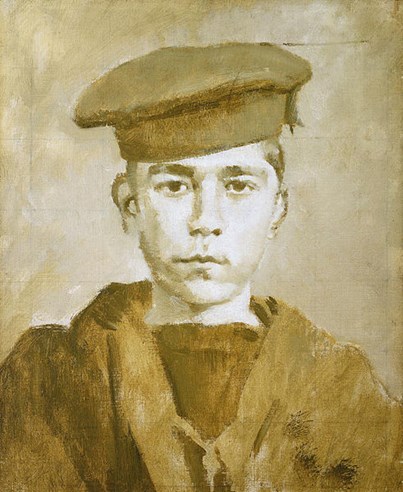
On the Easter Monday of 1916, Cornwell left for Rosyth, and was instructed to join his ship, HMS Chester, a brand new light cruiser which had not yet been commissioned.
The Fleets put to Sea
Unbeknown to the Germans, earlier in the war the British had acquired a set of German codes and were able to read supposedly secret communications via British Naval Intelligence code breakers. Thanks to these code-breakers, based in "Room 40" at the Admiralty in London, an order to the German High Seas Fleet was intercepted and deciphered.

The German plan was to tempt a small part of Britain's Grand Fleet out, sink the British capital ships (thus eliminating the British superiority in one fell swoop). Forewarned about the German naval activity, the British Grand Fleet, under Admiral Jellicoe put to sea from its bases in Scotland to intercept the German High Seas Fleet in the North Sea.
Admiral Jellicoe led the 16 dreadnought battleships of the 1st and 4th Battle Squadrons of the Grand Fleet and three battlecruisers of the 3rd Battlecruiser Squadron eastwards out of Scapa Flow at 10.30pm on 30 May. Part of the 3rd Battlecruiser squadron was Cornwell's HMS Chester.
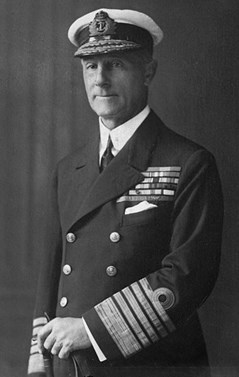
Admiral Jellicoe. Churchill described Jellicoe later as 'the only man on either side who could lose the war in an afternoon'
Jack Cornwell at Jutland
During the subsequent engagement, HMS Chester was hit by seventeen 150mm shells. This damage was not bad enough to sink the ship, but 29 men were killed and a further 49 wounded. Amongst the gun crew fatalities was the 16 year old Jack Cornwell.
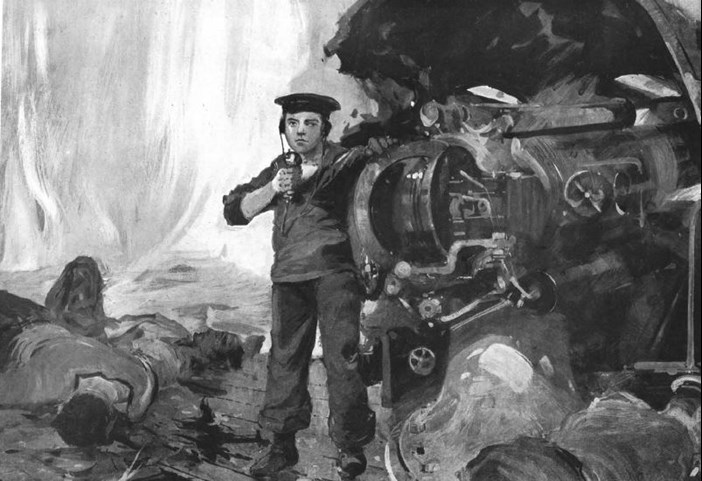
Jack Cornwell. Image from 'Deeds that thrill the Empire'

Jack Cornwell's funeral
His citation reads:
Mortally wounded early in the action, Boy, First Class, John Travers Cornwell remained standing alone at a most exposed post, quietly awaiting orders, until the end of the action, with the gun's crew dead and wounded all round him. His age was under sixteen and a half years.

Above: The Pension Record Card of Jack Cornwell - one of those located in the recently digitised archive. These records were saved by the WFA and are now a valuable research tool.
In the course of the Battle of Jutland, over 6,600 officers and men were killed or wounded on the British side, with a further 3,000 Germans killed and wounded.
Losses to capital ships
Five British capital ships went down with over 800 fatalities in each vessel.
The largest single loss of life was caused when HMS Queen Mary was sunk. She was the latest of the Royal Navy's battlecruisers, being commissioned only a year before the outbreak of the war. Nearly 1,300 men were killed on her.

The plume of smoke from HMS Queen Mary. One of her magazines was hit, causing a massive internal explosion. There were just 20 survivors.
Also sunk was HMS Invincible, an older ship completed in 1909. Hit in her 'Q' turret, the shell caused the magazine to explode, cutting her in two. She had a complement of over 1,000 men, only six survived. Five of the survivors were part of the team at the very top of the foremast. Incredibly, the sixth survivor was in 'Q' turret and somehow was blown clear. One of the fatalities was Rear Admiral Hood.
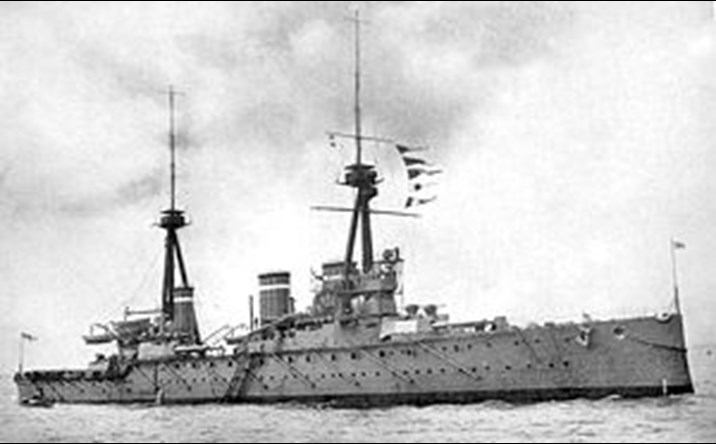
HMS Invincible before the war.

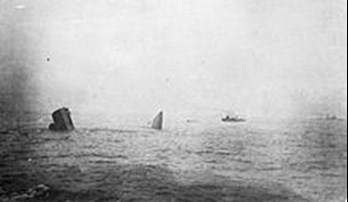
HMS Invincible hit and cut in two.
Another senior officer to lose his life was Rear Admiral Sir Robert Arbuthnot (image below) who was among 54 officers and 849 men who were killed on HMS Defence (an armoured cruiser). There were no survivors.
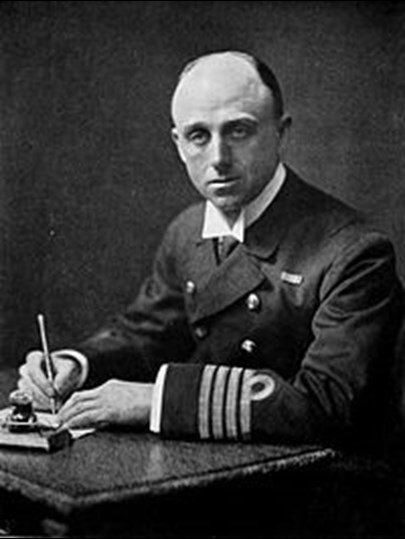
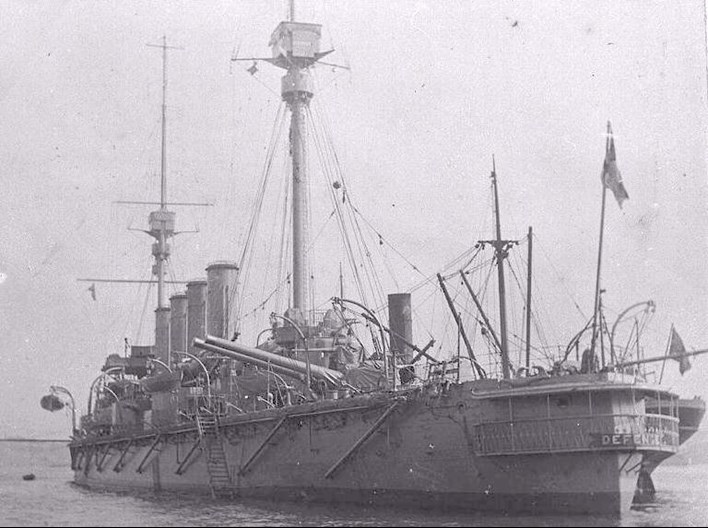
HMS Defence, (above) along with the other Jutland wrecks, was declared a protected place under the Protection of Military Remains Act 1986, to discourage damage to the resting place of the men who were killed when she went down.
Other massive losses of life included HMS Indefatigable (images below) which went down with 57 officers and 960 men (2 survivors were picked up by the Germans).

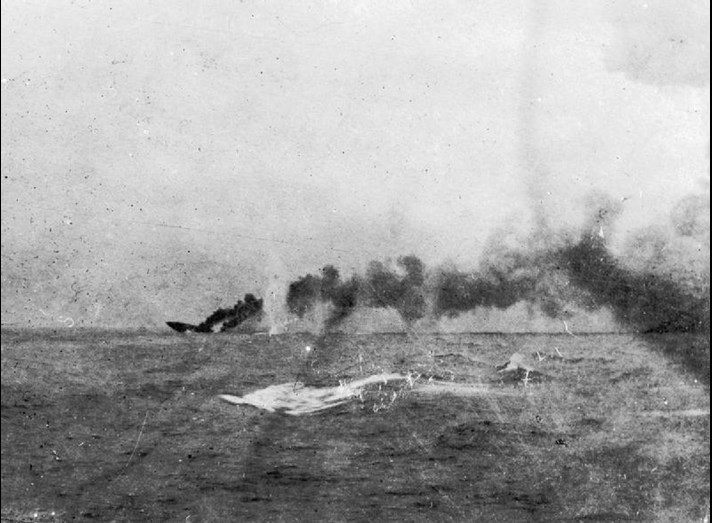
Above: HMS Indefatigable sinking
During a later part of the Battle, just before midnight, and separated from the rest of the British fleet, HMS Black Prince came across a number of German battleships. The Germans fixed the Black Prince with searchlights and opened fire. Up to six German ships joined in the bombardment, most of the German ships were between 750 and 1,500 yards of the Black Prince; this was effectively point blank range. Black Prince was hit by at least twelve heavy shells and several smaller ones, and sank within 15 minutes. There were no survivors.
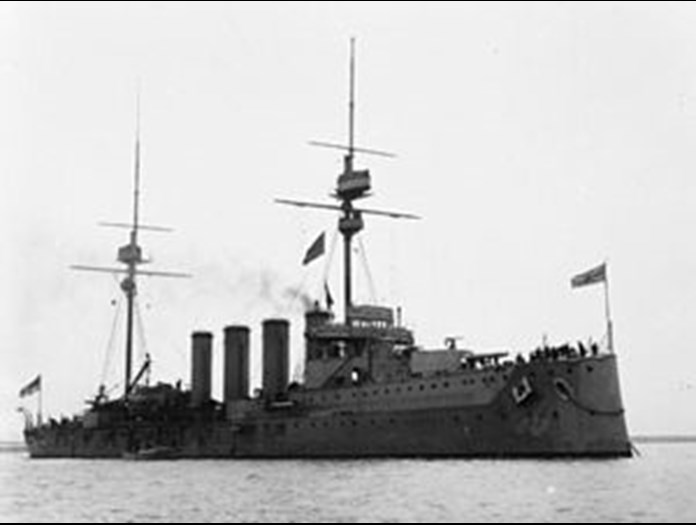
HMS Black Prince - killed: 37 officers 820 men
After the battle, which has been described as "indecisive", the British Grand Fleet returned to port, many of the ships with varying degrees of damage, including HMS Chester.
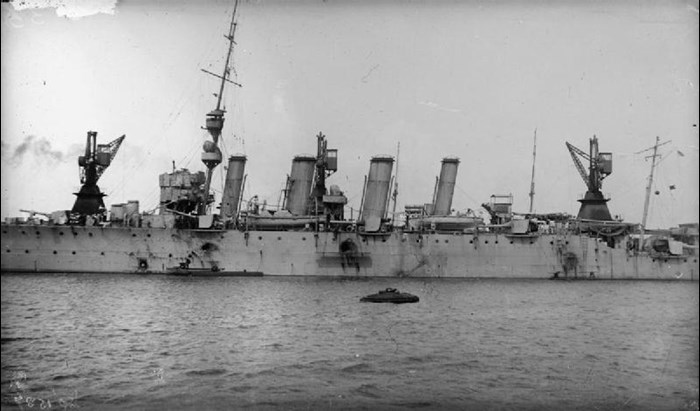
Damage to HMS Chester.

The Breech Loading 5.5 inch Mk I gun which Cornwell served has been preserved at the Imperial War Museum.
Jack Cornwell was not the only person awarded a VC for his part in the Battle of Jutland.
Other VC recipients
The Hon. Edward Barry Stewart Bingham was in command of a destroyer division at Jutland and led his twelve ships in an attack on the battlecruisers of the German High Seas Fleet. The German vessels turned away and, believing that contact would not be possible, Bingham did likewise. However, the German ships turned again, and so Bignham, on board HMS Nestor, (accompanied by HMS Nicator and HMS Moorsom) approached to 3,000 yards of the Germans, receiving increasing fire as more German ships brought guns to bear on the destroyers. Nestor was hit and disabled, requiring Nicator to veer off at the last minute from firing its torpedoes so as to avoid a collision.

Above: Commander Edward Bingham, VC
Commander Bingham ordered all charts and confidential books to be destroyed, and the ship's boats and rafts to be provided with water and biscuits and to be launched. He then ordered his crew to lay out cables, as if in anticipation of a tow, simply as an exercise to keep them occupied. Nestor sank at approximately 5.30 pm
Bingham was picked up by the Germans at Jutland, and remained a prisoner of war (latterly at Holzminden) until the Armistice. After the war, he remained with the Royal Navy and retired as a Rear Admiral in 1932 and died in 1939. The citation for Bingham's VC reads:
For the extremely gallant way in which he led his division in their attack, first on enemy destroyers and then on their battlecruisers. He finally sighted the enemy battle-fleet, and, followed by the one remaining destroyer of his division (Nicator), with dauntless courage he closed to within 3,000 yards of the enemy in order to attain a favourable position for firing the torpedoes. While making this attack, Nestor and Nicator were under concentrated fire of the secondary batteries of the High Sea Fleet. Nestor was subsequently sunk.
Meanwhile, on board HMS Lion was Major Francis Harvey of the Royal Marines. Badly wounded by German shellfire, he ordered the magazine of 'Q' turret on the battlecruiser Lion to be flooded. This action prevented the tons of cordite stored there from catastrophically detonating in an explosion that would have destroyed the vessel and all aboard her.

Above: HMS Lion's 'Q' turret.
Although he succumbed to his injuries seconds later, his dying act may have saved over a thousand lives and prompted Winston Churchill to later comment: "In the long, rough, glorious history of the Royal Marines there is no name and no deed which in its character and consequences ranks above this."

Major Francis Harvey (image above) is commemorated on the Chatham Naval Memorial.
Another VC recipient was Loftus William Jones of HMS Shark
An extract from the London Gazette dated 6 March 1917 records the following:
On the afternoon of the 31st May, 1916, during the action, Commander Jones in HMS Shark (image below) a Torpedo Boat Destroyer, led a division of Destroyers to attack the enemy Battle Cruiser Squadron. In the course of this attack a shell hit the Shark's bridge, putting the steering gear out of order, and very shortly afterwards another shell disabled the main engines, leaving the vessel helpless.
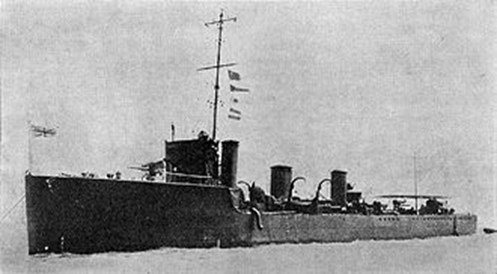
The Commanding Officer of another Destroyer, seeing the Shark's plight, came between her and the enemy and offered assistance, but was warned by Commander Jones not to run the risk of being almost certainly sunk in trying to help him. Commander Jones (image below), though wounded in the leg, went aft to help connect and man the after wheel. Meanwhile the forecastle gun with its crew had been blown away, and the same fate soon afterwards befell the after gun and crew. Commander Jones then went to the midship and the only remaining gun, and personally assisted in keeping it in action. All this time the Shark was subjected to very heavy fire from enemy light cruisers and destroyers at short range.

The gun's crew of the midship gun was reduced to three, of whom an Able Seaman was soon badly wounded in the leg. A few minutes later Commander Jones was hit by a shell, which took off his leg above the knee, but he continued to give orders to his gun's crew, while a Chief Stoker improvised a tourniquet round his thigh. Noticing that the Ensign was not properly hoisted, he gave orders for another to be hoisted. Soon afterwards, seeing that the ship could not survive much longer, and as a German Destroyer was closing, he gave orders for the surviving members of the crew to put on lifebelts. Almost immediately after this order had been given, the Shark was struck by a torpedo and sank.
Commander Jones was unfortunately not amongst the few survivors from the Shark who were picked up by a neutral vessel in the night. William Loftus Jones is buried at Kviberg, (photo below).
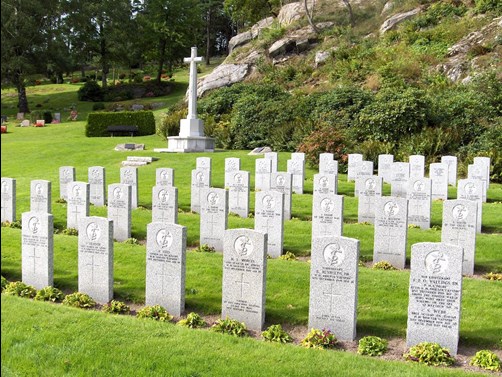

Above: The headstone of Commander LW Jones VC
As previously mentioned, over 6,000 men of the Royal Navy died at the Battle of Jutland. Most of these men have no known grave and are therefore commemorated at the CWGC's Naval Memorials at Plymouth, Portsmouth and Chatham. Others, however do have known graves and are buried in Denmark (12 identified burials) Sweden (24 identified burials) and Norway (30 identified burials).
These are some of the most remote CWGC First World War burials in Europe.
Kviberg Cemetery, near Gothenburg, on Sweden's west coast has 24 known and identified casualties from the Battle of Jutland. The cemetery contains a further 14 identified First World War casualties plus a further 30 from the same conflict who are 'unknown'. The plot here was created in 1961 when many inaccessible First World War graves were brought here from other parts of Sweden.
Tonsberg Old Cemetery, in Norway (image below), is about fifty miles south of Oslo. This cemetery has eight identified Jutland fatalities plus fourteen unidentified fatalities from the battle.

Also in Norway is Fredrikstad Military Cemetery (this is located on the other side of the fjord from Tonsberg). The original plot contained just seven identified Jutland sailors plus eleven unidentified men from the battle.

Above: Fredrikstad Military Cemetery
Later concentrations (totalling 64) from small burial grounds elsewhere in Norway took place in 1961; the majority of these were men who were killed at Jutland. The graves were marked by a granite memorial erected by the Norwegian government.
Denmark has no large concentrations of Jutland fatalities. Four men (including one 'unknown') are buried in Frederikshavn Cemetery (image below) on Denmark's north-east coast.
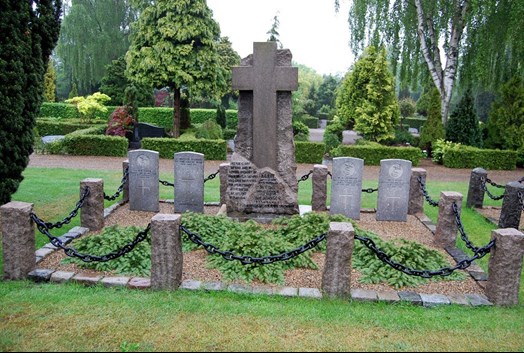
Seven men, two of whom are casualties of Jutland and five "probably" from the Battle of Jutland are buried at Skagen Cemetery on the tip of the Danish peninsula.
One of Britain's last surviving veterans of the First World War, and the last survivor of the Battle of Jutland was Henry Allingham.

Henry Allingham, who was born in 1896, died in 2009. He was 113.
After Jutland, the High Seas Fleet never again seriously threatened the Allied naval supremacy, the German strategy instead turned to the use of u-boats: this caused heavy losses to Allied shipping but ultimately helped to propel the USA into the war in 1917.
Further Reading:
Jutland, 1916: Death in the Grey Wastes by Nigel Steel and Peter Hart
"Naval historians have pored over the minutiae of Jutland ever since. Yet they have largely ignored what the battle was actually like for its thousands of participants. Full of drama and pathos, of chaos and courage, this book describes the sea battle in the dreadnought era from the point of view of those who were there."
Videos:
For Valour: A lecture on Great War Victoria Crosses by Mark Smith MA, Curator and Regimental Historical Secretary, The Royal Artillery Museum. Delivered in the Greenwich Heritage Centre Conference Room.
Planning Armageddon?: A lecture on The Royal Navy's strategic thinking and the provisions for war with Germany by Dr Scott Lindgren. Delivered at the Tally Ho! Club, Birmingham.
Podcast:
Jutland and the Meaning of Victory – Prof Andrew Lambert. This recording is of a talk given by Professor Andrew Lambert, King’s College London, to the Antrim and Down WFA branch Somme Conference in October 2016 on the outcomes of the 1916 naval battle at Jutland.
Research Resources:
Naval Pension Records can be found in the WFA's Pension Record Archive. For details see this article:
Release of Naval and Mercantile Marine Pension Records by Ancestry
Article by David Tattersfield, Vice Chairman, The Western Front Association





